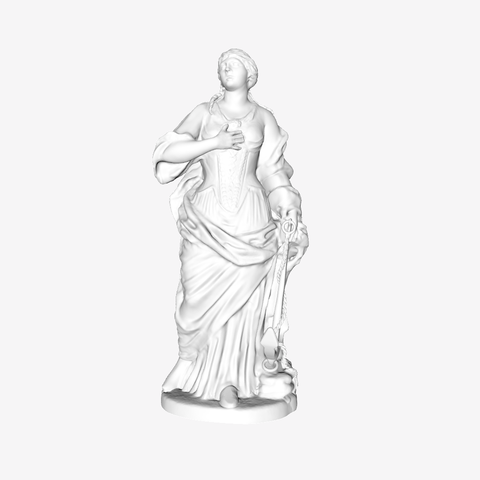
Saint Catherine at the Louvre, Paris
cults3d
This striking statue by French sculptor Thomas Regnaudin (1622-1706) embodies a self-proclaimed allegory of hope for the church. As a late Baroque sculptor, Regnaudin was renowned among the French nobility for his idealism, which clashed with the cynicism of the Baroque era. While it does not depict a woman interacting with death, this piece is a tribute to the martyr and reflects a woman's unwavering faith through the ultimate sacrifice. Church tradition has crowned St. Catherine as one of the most revered female saints in the early church. Her legendary faithfulness during torture was sealed by a profound testament that echoes across the ages; a young martyr in the 4th century, she became a Christian at the age of fourteen under the hands of Emperor Maxentius. Born into a family that governed Alexandria, she soon gained recognition for her beauty and intellect, which she sharpened through extensive study of the arts, sciences, and philosophies. She received a vision of the Virgin Mary presenting Christ to her in mystical marriage when she was just a young teenager, which converted her to Christianity. After her conversion, she vowed to remain a virgin throughout her life. A contemporary of Emperor Maxentius, who persecuted Christians, she visited him and debated with him in an attempt to alter his policy and end the persecution of the church. Maxentius pitted the best and brightest Roman philosophers and academicians against her, but she emerged victorious, converting them all to Christianity. Maxentius responded by killing them all in a rage, then attempted to make Catherine recant through torture. After rejecting Maxentius' subsequent marriage proposal, he ordered her beheaded on the spiked wheel, which miraculously broke when she prayed for rescue. When all else failed, Maxentius simply beheaded her. Although the historical accuracy of this account is highly debated among historians and most current scholars cannot find a historical counterpart that correlates with church tradition, her story remains an inspiring tale of devotion in the face of persecution. Regnaudin sculpted St. Catherine as a "symbol of hope." At first glance, this seems peculiar because Catherine was ultimately beheaded; however, the construction of the piece reveals the issue. Originally, Regnaudin placed her hand resting on a spiked wheel that miraculously broke due to her prayer in the midst of torture. She lifts her eyes heavenward with her hand on her heart - the epitome of prayer and devotion. Her face appears lost in her mystical union with Christ; such is her faith in God that instruments of torture cannot touch her. She stands regal, tall through difficulty, inspiring the viewer to hope through trials. This particular allegory of hope has had an unusual journey; it was originally mounted in St. Catherine Hospital in Paris, France, and sometime in the 19th century, the broken wheel was replaced with an anchor. Due to the tumultuous nature of that century for the French nation, various explanations arise for this exchange, but the actual cause remains unknown. It was moved to the Museum of French Monuments in the 18th century, and later, to the Louvre. Even with the anchor, it remains a symbol of hope. Her hand rests on an anchor just as her soul rested in Christ, the Anchor of faith. Regnaudin himself may not have been a believer, but it appears that he was commissioned to sculpt a statue for St. Catherine's Hospital, which housed numerous charitable institutions throughout the years. As the Baroque era is characterized by growing tensions and a desire to question traditional authority, many artists who created faith-related artwork used the stories as allegories for various virtues. Perhaps Regnaudin simply found the legend of St. Catherine inspiring and decided to sculpt an example of living, other-worldly hope. Whatever his personal beliefs, Regnaudin's choice to use a woman as a symbol of hope is not atypical - throughout much of the history of art, women are used as symbols of various virtues. This trend may have originated in the code of chivalry of the Middle Ages, which elevated women as unattainable beacons to fight for in their Virgin-like purity. Wherever its origins, it is a trend that establishes women as an ideal; it presents an optimistic perspective on suffering, showcasing a woman encountering death and overcoming it through faith.
With this file you will be able to print Saint Catherine at the Louvre, Paris with your 3D printer. Click on the button and save the file on your computer to work, edit or customize your design. You can also find more 3D designs for printers on Saint Catherine at the Louvre, Paris.
